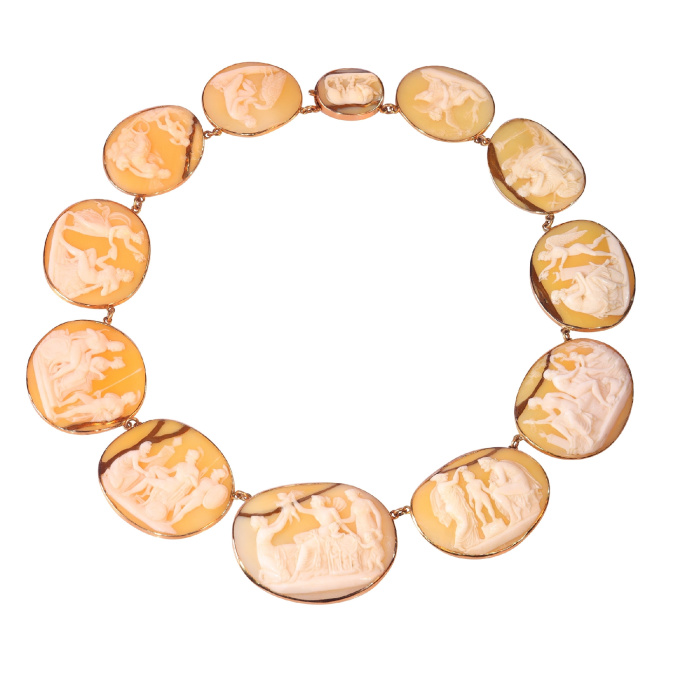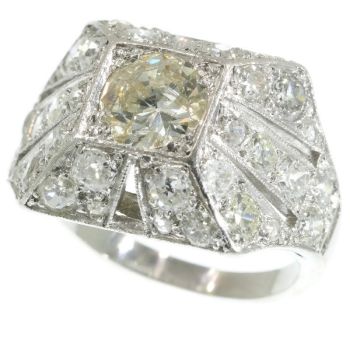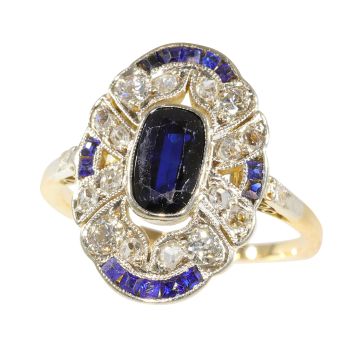French antique cameo necklace 1820
Artista Sconosciuto
€ 16.000
Adin Fine Antique Jewellery
- A proposito di opere d'arte
When we first took in this 18K red gold necklace of 12 neoclassical shell cameos, we immediately recognized the historical importance of this exquisite piece:
-First of all, two different hallmarks from two different eras in the gold mounts of the shell sceneries show that the cameos were brought to a French jeweller to be made into this necklace short after their carving around the beginning of the 19th century. We gladly point out the rarity of finding even one hallmark in a piece of such age.
-Secondly, we're convinced that the cameos are originally crafted in France or in Italy.
To start with France, this would be the easy assumption as the necklace was constructed there as well. Furthermore, Napoleon Bonaparte's (1769-1821) and his wife Josephine de Beauharnais' predilection for the grandeur of imperial Rome inspired them to found the Atelier Royal, which dedicated itself to the art of cameos and which was active in the same period as when this jewel was created.
However, we do clearly recognize the quality of the carving of the cameos to be of the same level as those by the Italian carving atelier of the globally renowned Saulini family. Influenced by the French imperial style, it was an exclusive trend to purchase such cameo souvenirs when visiting Rome and have them made into a jewel once back in France.
Either way -crafted by Atelier Royal or by Atelier Saulini-, we can safely state that these 12 scenes are based on reliefs or statues by Bertel Thorvaldsen (1770-1844), a praised Danish sculptor who often referred to ancient Greek and Roman mythology.
-At some point in the lifespan of this centuries old necklace, some of the shell cameos broke, which turned this former giant representative of its time into unwearable bits. That's where Adin fits in the picture of this jewel's existence, as we justcouldn't accept for this special piece to get lost in time. By applying the Japanese gold lacquer technique of Kintsugi, we gave the necklace back its purpose: it can function again as a proper jewel, it can be worn and admired again.
The inheritor of this statement necklace should exhibit its scars as an extra beauty feature telling a part of the jewel's life story and wear it with the honour of preserving multiple facets of history.
Antique jewelry object group: necklace
Condition: Originally some cameos were broken due to their long history, but we've repaired those with the art of kintsugi.
- (more info on our condition scale)
Country of origin: France
Style: Empire - The Empire style remains still today one of the most appreciated styles because of its value as the second phase of Neo-classicism. The Empire style has influenced decoration, architecture, as well as all forms of art. Although it was give rise in the first quarter of 1800, its development and expansion continued in time and went well beyond the French borders reaching most of Europe and America.
(N.B.: The Empire style corresponds to the "Federal style" in the United States and to the "Regency style" in Britain. An earlier phase of the style was called the "Adam style" in Great Britain and "Louis Seize" or "Louis XVI" in France.)
- See also: Empireor more info on styles
Style specifics: The Empire style is characterized by solidity and majesty, meant to reflect the power and sovereignty Napoleon I and his French state, known as the first French Empire. From a desire to correspond with the the ancient Greek and Roman empire, the samekind of elegance is reflected in the use of classical motifs, symmetry and harmonic and balanced proportions, however never eccentric or vulgar. In short, the Empire style is characterised by the conjunction of two tendences: on one side solemn, heroic,majestic; on the other contained, measured, discrete.
(N.B. Specific symbols of Napoleon's imperial grandeur is the emperor's monogram and his emblem: the bee, representations of military trophies, and later on Egyptian motifs after his campaigns in Egypt.)
Period: ca. 1820
- (fashion and events & facts of this era)
Source of inspiration: Mythology
Theme:
cameo Nº 1: Romulus and Remus (no Thorvaldsen inspiration)
cameo Nº 2: Ganymede with Jupiter's eagle
cameo Nº 3: Cupid Complains to Venus about a Bee Sting
cameo Nº 4: Hercules and Hebe
cameo Nº 5: Hector with Paris and Helen
cameo Nº 6: Priam Pleads Achilles with Hector's Body
cameo Nº 7: The Ages of Love
cameo Nº 8: Minerva and Prometheus
cameo Nº 9: Cupid, Bacchus and Ariadne
cameo Nº 10: A Genio Lumen (The Genius of Art and Light)
cameo Nº 11: Cupid Received by Anacreon
cameo Nº 12: Nor can we find a scene like this in the Thorvaldsen collection but neither did we find anything else resembling this scene.
Material: 18K red gold
- (more info on precious metals)
Technique of cameo: Cameo is a method of carving, or an item of jewellery or vessel made in this manner. It features a raised (positive) relief image. There are three main materials for cameo carving; shells, agate (called a hardstone cameo), and glass. Cameos can beproduced by setting a carved relief, such as a portrait, onto a background of a contrasting colour. This is called an assembled cameo. Alternately, a cameo can be carved directly out of a material with integral layers or banding, such as (banded) agateor layered glass, where different layers have different colours. Sometimes dyes are used to enhance these colours.
Cameos are often worn as jewellery. Stone cameos of great artistry were made in Greece dating back as far as the 6th century BC. They were very popular in Ancient Rome, and one of the most famous stone cameos from this period is the Gemma Claudia madefor the Emperor Claudius. The technique has since enjoyed periodic revivals, notably in the early Renaissance, and again in the 17th, 18th and 19th centuries.
Information about atelier Saulini: Works of the Saulini cameo carving atelier can be found in many important cameo collections around the world, like the Victoria & Albert Museum in London.Tomasso Saulini (1793-1864) was a pupil of Bertel Thorvaldsen, a famous Danish sculptor who spent much of his career in Rome. In general, Thorvaldsen's bas reliefs in a classical style were widely replicated, and so did Tomasso together with hispartnering son Luigi for atelier Saulini.
Take a look at all the pictures and you'll see that we were able to trace back almost all of the original works used as inspiration for this necklace.
Technique of kintsugi: With this traditional Japanese craft, called Kintsugi, broken ceramics are not only being fixed, but even lifted to a state of art by using a mixture of gold and lacquer as a strong yet beautiful cohesive substance for the shards. It's all in the name of the technique: "kin" meaning "golden" and "tsugi" meaning "joinery", resulting in the translated term of "golden repair".
By applying the technique of kintsugi to objects in general, these objects start to symbolize a way of living, a philosophy that embraces imperfections. It aligns with the zen-ideal of wabi-sabi and the Japanese expressions of "mottainai" and "mushin",which teach us to respect and appreciate all that has aged, to prevent waste and to accept change. There's beauty in everything, even more so in things that show the influence of life on their very existence -even if those signs are called animperfection or a scar.
Precious stones: Twelve cameos of shell
- (more info on precious stones)
Hallmarks: In the stage-left eyelet on the largest middle cameo, we've discovered the French control mark for 18K gold representing a ram's head that was in use in France from about 1817 and in the closure a double eagle's head that was in use in France from about1838.
- (more info on hallmarks)
Dimensions: total length 45,50 cm (17,91 inch)
Weight: 50,70 gram (32,47 dwt)
Reference Nº: 15164-0121
Copyright photography: Adin, fine antique jewelry
- A proposito di opere artista
Può succedere che un artista o un creatore sia sconosciuto.
Alcune opere non sono determinate da chi sono state realizzate o sono state realizzate da (un gruppo di) artigiani. Esempi sono statue dell'antichità, mobili, specchi o firme non chiare o leggibili ma anche alcune opere non sono affatto firmate.
Inoltre puoi trovare la seguente descrizione:
•"Attribuito a …." A loro avviso probabilmente opera dell'artista, almeno in parte
•“Studio di ….” o “Officina di” A loro avviso un'opera eseguita nello studio o nella bottega dell'artista, eventualmente sotto la sua supervisione
•“Cerchio di…” A loro avviso un'opera del periodo dell'artista che mostra la sua influenza, strettamente legata all'artista ma non necessariamente al suo allievo
•"Stile di..." o "Seguace di..." A loro avviso un'opera eseguita nello stile dell'artista ma non necessariamente da un allievo; può essere contemporaneo o quasi contemporaneo
•“Modalità di…” A loro avviso un'opera nello stile dell'artista ma di epoca successiva
•"Dopo …." A loro avviso una copia (di qualsiasi data) di un'opera dell'artista
•“Firmato…”, “Datato…” o “Iscritto” A loro avviso l'opera è stata firmata/datata/inscritta dall'artista. L'aggiunta di un punto interrogativo indica un elemento di dubbio
•"Con firma....", "Con data...", "Con iscrizione..." o “Riporta firma/data/iscrizione” a loro avviso la firma/data/iscrizione è stata aggiunta da qualcuno diverso dall'artista
Sei interessato ad acquistare questa opera d'arte?
Related artworks
Unbekannter Künstler
WICHTIGE UND SELTENE GROSSE INDISCHE 'COMPANY STYLE'-MALEREI AUF Elfenbein, die eine Parade darstell1850 - 1900
Preis auf AnfrageZebregs & Röell - Fine Art - Antiques
 Kuratiert von
Kuratiert vonDanny Bree
1 - 4 / 12- 1 - 4 / 12































